1977 Brazilian Grand Prix race report
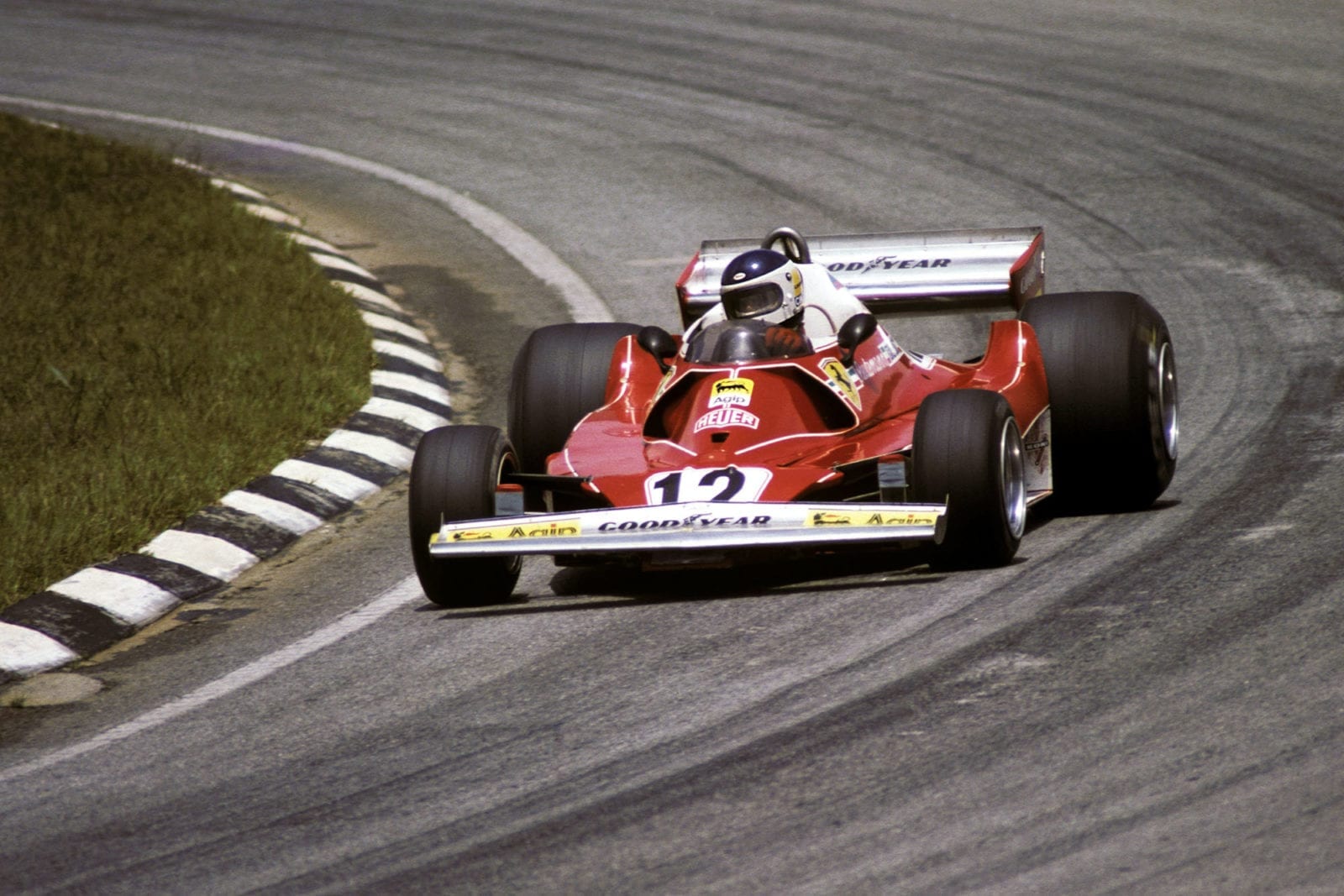
Carlos Reutemann took his first Ferrari win at Interlagos
Motorsport Images
Reutemann wins through the carnage
Sao Paulo, January 23rd
After two weeks of feverish activity following the Argentine Grand Prix, the second round of the 1977 World Championship series took place at the sinuous, bumpy 4.946-mile Interlagos track amidst the bustling suburbs of Sao Paulo in Brazil. Although many of the drivers enjoyed an easy time relaxing on sun-soaked beaches along the South Atlantic coast, for a lot of mechanics and team owners there were far more serious things to worry about. The McLaren camp, naturally concerned over the rear suspension breakage that had sent Hunt off the road in M23/8 while he was leading the Argentine Grand Prix, beefed up the rear and of the World Champion’s car with a new bellhousing and an enlarged replacement for the stud that broke in the rear suspension. The second car driven by Mass had also been modified. For Team Lotus the problem was much larger, because they had to ship back to Hethel their badly damaged Lotus 78/2, the front of which had been blown off when the car’s fire extinguisher bottle exploded during practice at Buenos Aires. Tony Southgate in fact left for home on the night before the Argentine Grand Prix, but it wasn’t until Tuesday that the damaged chassis finally arrived in London owing to the inevitable surplus of red tape encountered from Britain’s nationalised airline. The car was rushed back to the factory, stripped down and repaired, before being flown out again to South America in time to be rebuilt into an operational machine shortly before official practice began. It was the sort of marathon that depends upon efficient timing, ceaseless work and a lot of single-mindedness, and as Andretti’s black and gold car stood waiting for the first session to get under way, one couldn’t help marvelling at the sheer effort put in by racing mechanics in general to get their cars to the starting line.
Other minor dramas included the airline’s temporary mislaying of the spare Shadow DN5 and of one of the Surtees TS19s, plus some Tyrrell nose sections went missing; but otherwise all the teams managed to arrive at Interlagos intact. On a light-hearted note, somebody got the paperwork rather muddled in the local airline office with the result that the spare Wolf monocoque was officially documented as a Brabham-Alfa Romeo, the resulting confusion giving Peter Warr quite a headache as he tried at Rio to get the car off the cargo plane mistakenly taking it back to Europe! The Brabham team itself had to rely on one car as BT45/1 had been too badly damaged by Pace during practice for the Argentine Grand Prix to be repaired locally. Designer Gordon Murray flew back to Britain between the races to superintend the development of his new car, only to spend the best part of a week attempting to track down the damaged Brabham; it was eventually located, secure in its crate, at Rome Airport. The marvels of modern transportation!
After their promising showing in Argentina, where Watson and Pace both led the race on separate occasions, it was clear that the Brabham-Alfa Romeos would be a serious force to be reckoned with, especially at Pace’s home circuit where he had previously triumphed in the 1975 Brazilian Grand Prix at the wheel of a Brabham-Cosworth BT44B. Pace had been training hard with a local football team for several days prior to practice, for although he is used to intense heat the body temperature can rise alarmingly inside the triple-lever flameproof overalls that are de rigueur for the modern Formula One driver. Apart from that, Pace’s heat exhaustion in Argentina was partially due to a virus he had picked up, and he was anxious to appear completely fit for this very important race.
Qualifying
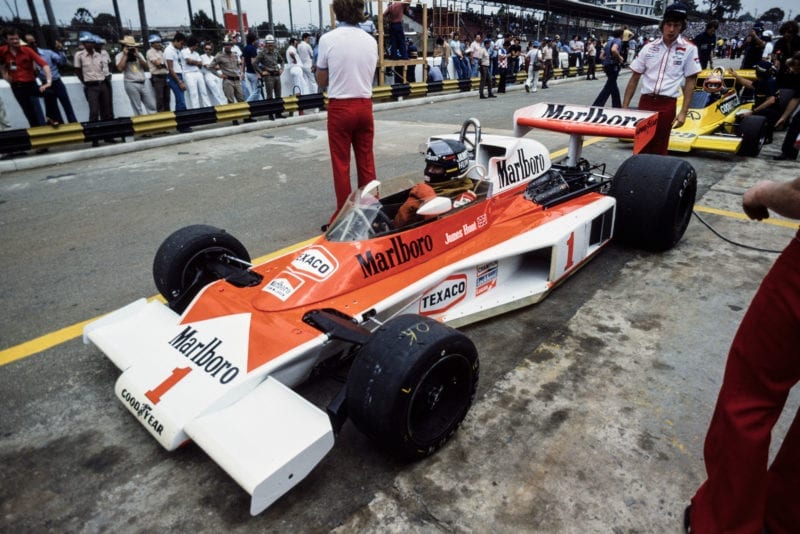
James Hunt put his McLaren on pole
Motorsport Images
In the opening timed session, competition between the Brabham, Lotus and McLaren teams proved extremely fierce, but it was Pace who emerged on top, much to the delight of the partisan crowd, lapping in 2 min. 30.57 sec. Andretti emphasised that he wasn’t to be shaken off by setting a promising 2 min. 30.83 sec during the second session, which left Hunt a close third on 2 min. 31.29 sec., slightly ahead of his on-form team-mate Jochen Mass in the second M23. Hunt was another who hadn’t been feeling terribly well prior to the Brazilian race, having contracted a touch of “Aztec two-step” during his stay in South America. Through the speed trap on the main straight Pace’s Brabham was more than 10 m.p.h. faster than its rivals during that first session, which suggested that Alfa Romeo really had been very busy indeed during the winter.
John Watson wasn’t able to match Pace’s performance, saying that his BT45 felt too sensitive over the bumps and that he wasn’t really satisfied with the engine. Its lack of response was later attributed to a failing cylinder head gasket and the unit was changed in time for the second day. In the Lotus pit Nilsson was sucking through his teeth slightly after his first run round Interlagos, the young Swede getting his 1977 season under way at the second race after being forced to hand his car over to Andretti in Argentina. Nilsson hadn’t been to Interlagos before, but he recorded a respectable 2 min. 34.37 sec. on the first day of practice as he concentrated on learning the circuit before attempting any adjustment to the car.
In the Ferrari camp there was an air of reserved optimism with the arrival of Engineer Forghieri from Maranello, but although Reutemann was to enjoy a largely trouble-free practice, Lauda’s problems seemed to multiply as the hours passed. Reutemann’s best on Friday was 2 min. 31.97 sec., the Argentinian not happy with slight understeer problems on the faster corners, while Lauda was in and out of the pits having all manner of adjustments made to the front and rear suspension settings. There were some very animated discussions between Forghieri and Lauda, the Italian insisting that the car should behave in such-and-such a manner on one particular setting while the impassive Austrian quietly insisted that, whatever the engineer thought, the car certainly didn’t. It was an untypically fraught scene for the Austrian to be involved in, and it came to a head when Lauda insisted on changing to softer rear springs, did one lap, and then insisted that harder springs were re-fitted because the softer ones failed to make any difference. Lauda could manage no better than 2 min. 32.37 sec. by the end of Friday’s two timed sessions, leaving the circuit displeased but determined to get to the bottom of the problem on Saturday.
The world of motor racing always seems to turn up a little bit of irony at every race. In Buenos Aires the irony was to see both the Brabham-Alfa Romeos qualifying faster than Carlos Reutemann (the man who had left Ecclestone’s team because he didn’t consider the cars to be competitive). In Brazil it was the sight of Clay Regazzoni, the man who was dismissed by Ferrari to make room for Reutemann, ending the first day’s practice with Nunn’s Ensign faster than either of the Italian cars. Regazzoni was on fine form, bringing a smile to all the Walsall faces in Nunn’s pit with an excellent best of 2 min. 31.69 sec. He was to lose this advantage to Reutemann on Saturday, but the Ensign’s engine was far from freshly rebuilt, and everyone in the little British team felt very encouraged and happy with the rugged Swiss driver’s performance.
Argentine Grand Prix winner Jody Scheckter found his Wolf WR1 very hard work at Interlagos, twitching and weaving over the bumps in a very tiring fashion as well as suffering from a slight electrical misfire on the first day. Nevertheless, his best effort of 2 min. 32.81 sec. made him fractionally faster than Emerson Fittipaldi, the Brazilian twice World Champion whose Copersucar-sponsored Formula One cars are built in a small factory just outside the gates of the Interlagos circuit. It was exactly one year since the Copersucar FD04 had appeared for the first time, and E.F. didn’t exactly radiate confidence about the car on this occasion, the driver admitting that whilst his car might be reliable it felt just about the same as it had 12 months earlier. He failed to improve on 2 min. 32.94 sec., although a delaminated tyre hampered his attempts to record a really quick time in the early stages of the second session. Ingo Hoffman drove the team’s second car again (this will not be a regular arrangement during 1977), but an experiment with a locally made ignition system which refused to work at all over 7,000 r.p.m. wasted most of Friday for the second Copersucar entry.
After their disappointing showing in the Argentine, Ken Tyrrell and Derek Gardner were hoping for better things with the sleek Tyrrell P34s at Interlagos. Sadly, their fortunes didn’t seem to be any better for a change of country. Although both Peterson and Depailler were extremely fast in a straight line, both drivers suffered from such vicious terminal understeer that they were having to throw their machines virtually sideways on the entrance to the corners to ensure that they got round the bends at all. Peterson, in particular, was cornering in a series of spectacular full-lock slides that we haven’t seen since his Lotus 72 days, but he couldn’t better 2 min. 33.29 sec. Depailler was fractionally faster on 2 min. 32.99 sec., but he was similarly pessimistic about the car’s twitchy ride over the bumpy surface. In the Shadow team Pryce was working just as hard as the Tyrrell drivers to record a 2 min. 34.32 sec., which was a good deal quicker (as it should have been) than his sponsored team-mate Remo Zorzi, who at least had some experience of the circuit after driving Frank Williams’ old FW04 in last year’s Brazilian Grand Prix.
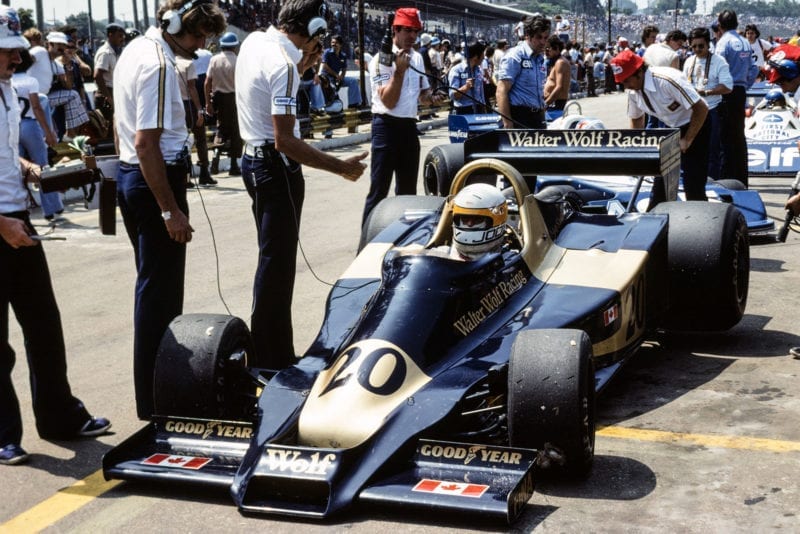
Jody Scheckter in the pits
Motorsport Images
Pressing on as enthusiastically as ever, Vittorio Brambilla knocked one of his Surtees TS19’s front water radiators off on a high kerb after managing a 2 min. 33.19 sec lap; but John Surtees was facing bigger problems with the inexperienced Binder, who started practising the team’s spare TS19/01 after airlines delayed the arrival of TS19/02 from Buenos Aires. The Austrian driver lost control on the very fast fourth gear Curva Jo Sol, crashing heavily into the barrier on the exit of the corner and writing off his car in the process. Ian Scheckter lost the nose section of his March 761B as he dodged through the wreckage but Binder emerged from the shattered car with nothing injured but his pride. Incidentally, neither of the two works Marches was particularly quick, local lad Ribeiro recording 2 min. 36.70 sec., 0.16 sec. quicker than Scheckter.
During the final timed session that counted for grid positions on Saturday morning, Hunt really excelled himself with a tremendous and well-worked-out 2 min. 30.11 sec. to ensure that pole position was well beyond doubt. Reutemann joined him on the front row with 2 min. 30.18 sec., the Ferrari’s revised rear wing helping matters enormously. Andretti clung on to the inside of the second row with a good 2 min. 30.35 sec., a time achieved despite his Lotus having to run with several gallons of “dead” fuel in its tanks owing to a pick-up problem, while Mass backed up the World Champion magnificently with a 2 min. 30.36 sec. best. Pace failed to improve, so his best Friday time of 2 min. 30.57 sec. left him in fifth place but Depailler lifted Tyrrell spirits with his car softer sprung than before and moved up to sixth place with 2 min. 30.69 sec., the last contestant to break the 2 min. 31 sec. barrier. Watson and Peterson shared the fourth row ahead of Regazzoni—his Ensign’s engine smoking a little—Nilsson, Brambilla and Pryce. Down in 13th position on the grid was a disgruntled Lauda, his regular car having sprung a fuel leak into the cockpit during that crucial final session in which he was hoping to make up all the leeway he had lost messing about the previous day. There was nothing left for Lauda but to switch to the muletta and he had to rely on his 2 min. 32.37 sec. time from the first session for his grid position.
Further down than expected, Jacques Laffite had a miserable two days with the Ligier-Matra JS7, one engine blowing up during pre-practice testing and another during the first timed session. The team then had to chase to Sao Paulo’s international airport (which is more than 60 miles outside the city!) to collect another fresh V12 which had been sent from France. The problem with the French-built engines surrounds the valve clearance in the cylinder heads, and Ligier was left with just the single unit for both the final timed session and the race. Laffite got down to 2 min. 32.43 sec. in the final session which was better than both the Scheckters, both the Copersucars, Zorzi, Binder, Ribiero and Perkins in the BRM, all of whom had been practising intensely ever since the track opened. Mention of Perkins brings us to the subject of the BRM P207, that new car from Bourne which has been designed by Len Terry. Barely ready to move, let alone race, the BRM predictably overheated madly in the Brazilian heat and minor problems with certain aspects of its fuel system couldn’t detract from the fact that the whole team was in a state of total unreadiness. Perkins could only manage 2 min. 42.22 sec. with the BRM and, since we saw him qualify 12th out of 24 at Watkins Glen in a Brabham BT45, we feel we know what conclusion it would be accurate to draw. Some people never learn; or perhaps they don’t want to.
During the untimed session at the end of Saturday afternoon Andretti was the centre of attention once more when his Lotus burst into flames whilst negotiating an infield hairpin, the result of a leak somewhere deep in the engine’s fuel system. The American leapt out hurriedly with only a few superficial burns on his overalls while the car coasted to a halt on the grass, and marshals quickly extinguished the blaze. Andretti “thumbed a lift” back to the pits on the side of his mate’s car, Nilsson looking a little bit apprehensive when he saw the other Lotus going up in flames because he thought he might be relegated to the role of spectator again. Fortunately the industrious Lotus mechanics worked through the night and rebuilt the car to that the “Racer’s racer” didn’t have to impose on his team-mate for the second successive race.
Race
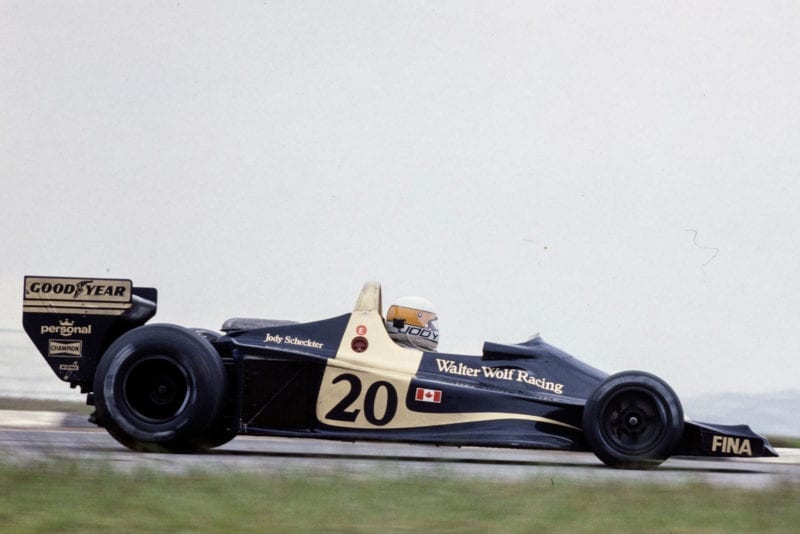
After winning the previous race, Scheckter found himself starting in 15th at Interlagos
Motorsport Images
At a couple of minutes to twelve o’clock (untypically punctual by South American standards!), the 22-car field moved slowly up from the “dummy” grid to await the starting light. At mid-day precisely, the starting light blinked green and the Brazilian Grand Prix was on with Pace jumping the start from the third grid and rocketing up the inside of Hunt as they went into the first corner. Reutemann chopped across from the outside and just led the Brabham-Alfa out onto the long downhill straight, but Pace had the bit between his teeth and hadn’t any intention of being shown the way round Interlagos by an Argentinian. At the bottom of the hill, on the entrance to the slightly banked double left-hander which was to cause to many people so much trouble later in the race, Pace pulled out and sliced into the lead to the accompaniment of estatic cheers from the crowd, leading the Ferrari up into the infield loop and out onto the start/finish straight to complete the first lap. Third was Hunt ahead of Mass, Andretti and Regazzoni, while there was already a gap opening back to Depailler, Laffite, J. Scheckter, Peterson, Brambilla, Pryce, Fittipaldi, Watson, Lauda, I. Scheckter, Nilsson (heading for the pits to change a rear tyre damaged after a slight nudge), Binder, Ribiero, Hoffman and Zorzi. Totally unnoticed by most of the spectators, the BRM crawled into the pits to retire with all its water blown out after just a single lap.
Although Pace was very much in command during the opening stages, Hunt was on fine form and slipped into second place on the third lap, but he wasn’t able to do much about the Italian-engined car in the lead. Hunt later remarked that he was amazed by the speed at which Pace got away from him along the straights, but he wasn’t giving up worrying the Brazilian as hard as he knew. Just behind Reutemann, Mass was striving might and main to fend off Andretti while the cheeky “Regga” simply hung onto the back of this little elite group and watched the action, quite able to keep up with them in “the car that Mo built”. Brambilla was already in the pits having a water radiator repaired after humping over yet another kerb, lan Scheckter had stopped with gearbox trouble on the second lap (the oil filter mounting had broken, severed an oil line and starved the box of its lubricant) and Nilsson was back in the fray driving as hard as he could from the rear end of the field.
A small grass fire suddenly started on the edge of the circuit on the outside of the corner before the pits, causing the leaders to moderate their speed for a couple of laps, but that was soon extinguished. By the end of the sixth lap the first half dozen were still in close contact, but lap seven spelt disaster for Pace as he rounded the double left-hander at the bottom of the hill after the pits. The circuit surface at this point had only recently been relaid and, as the race wore on, adhesion was minimal if drivers allowed their cars to deviate too much from the prescribed “line”. Pace allowed the red Brabham to run a fraction too wide as he led the field into this comer and suddenly Hunt was presented with the sight of the red Brabham sliding down the circuit almost broadside right front of him!
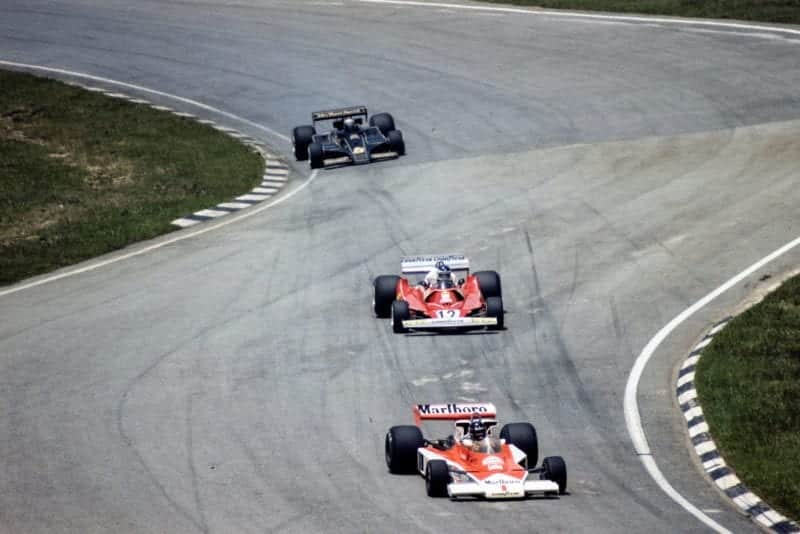
Hunt leads Reutemann and Andretti
Motorsport Images
Hunt pulled the McLaren into the corner as tightly as he could, slipping past Pace on the inside, but his right rear wheel ran over the Brabham’s left front water radiator, smashing the cowling and cascading water all over the place. Pace then regained control, but the whole nose section flew off a few hundred yards later and, bitterly disappointed, the Brazilian was obliged to stop at the pits at the end of that lap. Thus the order at the end of lap seven was Hunt from Reutemann, Mass and Andretti with the German driver trying as hard as he could to keep the determined American behind him.
On lap 11 Jody Scheckter pulled to a standstill with a seizing engine in his blue Wolf, then two laps later Mass lost control in front of Andretti at “that” comer, found himself unable to retrieve the situation on the slippery surface and slid headlong into the catch fencing. The fencing promptly fell down across the track, collected Regazzoni’s Ensign—which had also run slightly wide— and spun the Swiss’ car round in its own length before wrapping it up in chicken wire so that it was completely trapped!
Hardly had Regazzoni stopped than Depailler arrived on the scene, spinning wildly, but the Frenchman kept his Tyrrell away from the fence and was able to restart after losing several places. Peterson, by contrast, simply didn’t seem to see the pile-up and, to the amazement of the following Tom Pryce, simply ploughed straight off into the catch fencing. Brambilla was already there (having spun off a lap before Mass) while Watson and Lauda just avoided sliding off to join them. “It was just like black ice,” remarked an amazed Lauda after the race was over.
This wholesale decimation rather split up the field, Hunt now a few seconds ahead of Reutemann with Andretti right behind. Pryce’s Shadow had moved into fourth place ahead of Laffite with 15 laps completed, but the French car lasted there only six laps before making a pit stop to change cracked sparking plugs (a repeat of the problem that dogged Laffite in Argentina) and that meant that Lauda and Watson inherited the two remaining positions in the top half-dozen.
At the front of the field Hunt was clearly in problems as his McLaren had been adjusted to develop slightly too much understeer as the race wore on. Gradually Reutemann closed in on the McLaren as it wore its front tyres down and, despite trying extremely hard to fend him off, Hunt was forced to concede the lead on lap 23. Immediately Hunt took the decision to stop for two fresh front tyres, rocketing back into the race in fifth place and quickly re-passing Lauda and Watson. Two laps earlier Andretti’s strong challenge evaporated when a small electrical short circuit in the wires behind the Lotus’ instrument panel caused him to stop out on the circuit, so that left Reutemann with a tremendous lead over Pryce with Hunt catching up fast in third place. Even Pryce wasn’t without his problems, for his Shadow’s oil temperature was soaring, so the Welshman eased his pace slightly, hoping that the engine would last. Unfortunately, just over six laps from the end of the 40-lap race the engine went ragged and Pryce had to stop, so Hunt was back in second place behind Reutemann’s reliable Ferrari.
Depailler was further delayed after his spin with a deflated rear tyre and damaged water radiator (both of which had to be replaced) and the Frenchman capped Ken Tyrrell’s day by crashing very heavily into the remains of Mass’ McLaren, writing off both cars and braising his knees quite painfully. Watson, who never featured in the high places at all, found his Brabham BT45 understeering far too violently, and joined the happy throng in the catch fencing on lap 30. When he arrived and climbed out of his car he found that Laffite had slammed the Ligier-Matra into Brambilla’s Surtees and three laps later came the crowning stupidity when Pace (many laps behind the leaders) slid off into this Formula One graveyard as well. In all this excitement hardly anybody noticed Hans Binder sliding off further round the circuit after a front brake of his Surtees TS19 locked on!
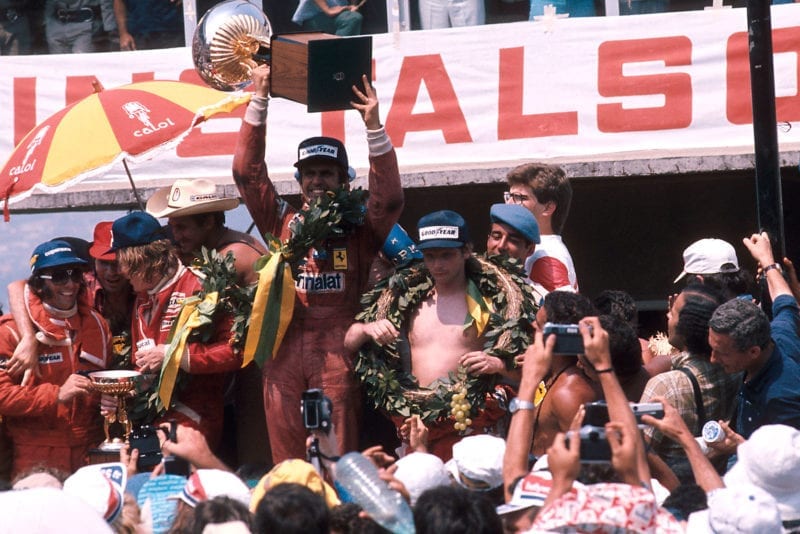
Reutemann celebrates his win
Motorsport Images
As the seven drivers in amongst the catch fencing dusted themselves down, the closing lap order of the Brazilian Grand Prix must have left than a trifle embarrassed. Reutemann, driving as smoothly as clockwork, reeled off the final miles to a comfortable and convincing victory over Hunt by as over 10 sec. while Lauda, who’d carefully avoided the pitfalls and snares other people found so attractive, ended up a solid and lonely third. Despite making a pit stop to change a deflated tyre, Fittipaldi brought the Copersuca home fourth (one lap down on Reutemann), while Nilsson survived to fifth (despite a second stop to take on fuel) and Zorzi was sixth simply by dint of plodding on. Hoffman was seventh and last, another who kept his car going—and on the track. A race which started with tremendous promise had ended as the survival of the three fittest with several “walking wounded” smiling along behind. Reutemann hadn’t been the fastest man on the track, but he’d gone fastest for longest with as little trouble as possible, which is surely what Grand Prix racing should be all about.—A.H.
